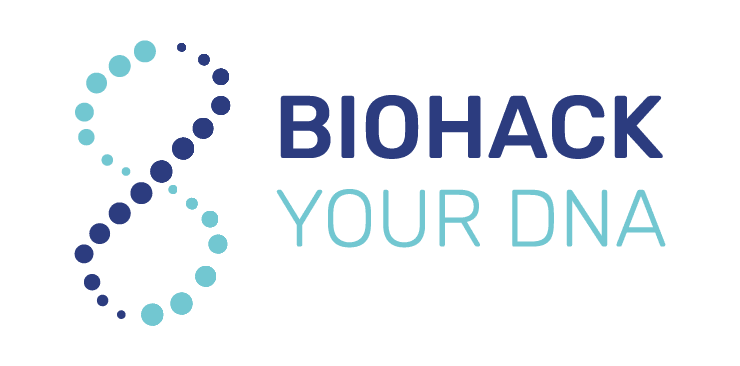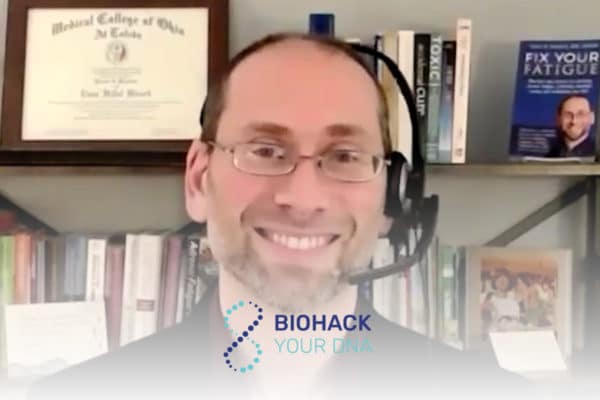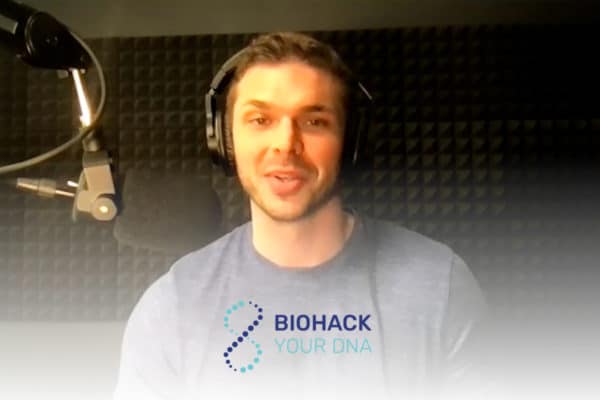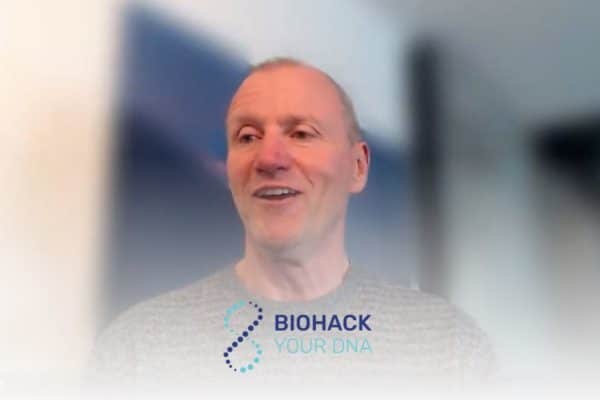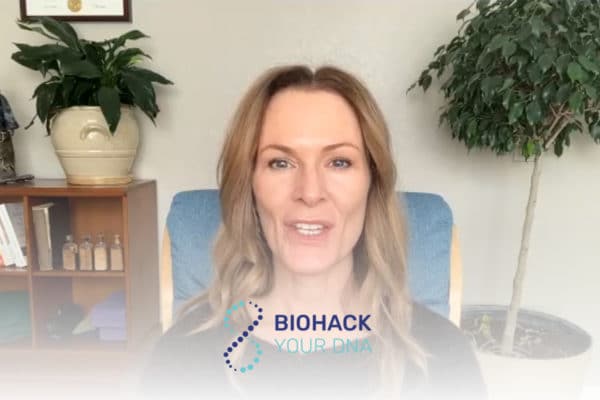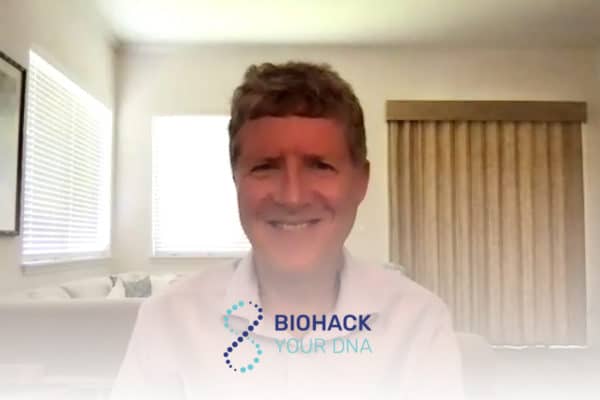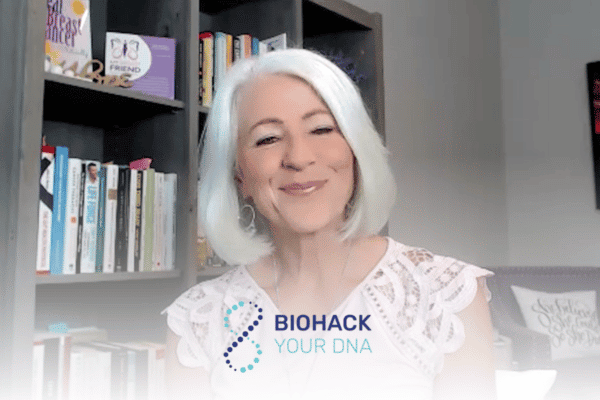Join the discussion below

Kashif Khan is the Chief Executive Officer and Founder of The DNA Company, where personalized medicine is being pioneered through unique insights into the human genome. With the largest study of its kind globally, The DNA Company has developed a functional approach to genomic interpretation overlaying environment, nutrition, and lifestyle... Read More
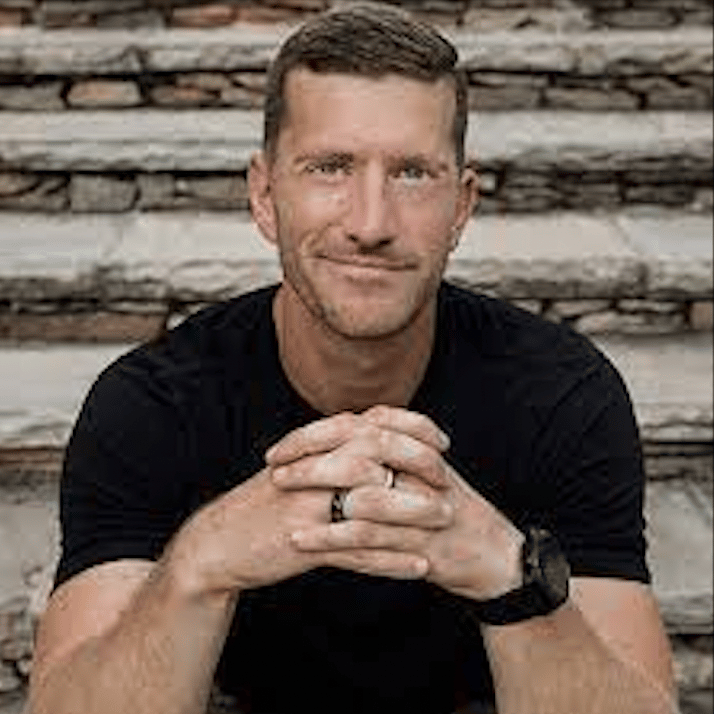
Dr. Jay Wiles is an international speaker, scientist, clinician, influencer, and subject-matter expert and authority on the interconnection between the human stress response and health performance/optimization. Dr. Wiles is a clinical health and performance psychologist with board certification in heart rate variability biofeedback and peripheral biofeedback and works as a... Read More
- The bidirectional relationship between stress and physiology
- How HRV is the best non-invasive proxy for assessing nervous system changes
- The myth about stress and why your body needs it
Kashif Khan
All right, everyone we’re back. And today we’re talking to Dr. Jay Wiles. We have some cool stuff to go through. Something that I personally need to deal with, which is me slowly killing myself with the stress load I’ve been taking on. People, even when I look in our own office, the way people handle it, the way people deal with it, the way it’s even perceived is so different for different people, the physiological response, the mental response. So we’re gonna dive into a lot of that stuff. We’re also gonna look at heart rate variability and some of the myths that we think we’re getting out of this and some of what we need to get out of it that we know we’re getting out of it. So first of all, welcome.
Dr. Jay Wiles
Thanks so much. Glad to be here, man.
Kashif Khan
So you don’t seem stressed at all. So it’s like you crack the code.
Dr. Jay Wiles
I just know how to hide it, that’s it. I can mask it well.
Kashif Khan
Yeah. So just in a nutshell, what is stress? People misunderstand, like what does this even mean?
Dr. Jay Wiles
Yeah, great question. Stress is ubiquitous, right? It is something that every single person experiences. And I think a lot of times we think about stress in terms of like a mental health problem. And so stress even in itself can become stigmatized, but no, stress is actually much more broad than that. I think the best way to conceptualize stress is that it has many different sides to it. And I would even argue many different faces. So the first one would be is that there is indeed true, good stress or stress that works to our advantage can increase performance productivity and in wellness. And then there is stress that can actually work against us and can be deleterious, but in and of itself, stress actually all about adaptation and stress really is there to save you. It is there to help you not to harm you.
And I think that that’s the problem is that within our modern day society, when we hear that word stress, the first thing that’s conjured in our brain is bad. Like stress is bad, actually no at the core of stress is good. It is there evolutionarily to help you, to aid you. What is stress? It’s a warning sign first and foremost, stress tells us that we need to check in with our environment when we experience something, especially if it’s internalized or psychological stress, it’s a warning sign, but also too stress can come in the form of physiological stress. Well, why do we exercise? It’s actually a form of stressing the body. We might refer to it as hormesis or hormetic stress. It’s this small insult to the body, if you will, that can help to make us bigger, faster, stronger. So to put ’em into their two categories, the best way that this has ever been conceptualized is by Dr. Hans Selye very famous researcher on the human stress response.
And he identified two really specific forms of stress. Distress, which is what most people think about when they think about stress. They think about the stress that beats us down. The one that’s really challenging, the thing that causes problems. But then there’s also eustress and eustress is the one that can help motivate us, can increase productivity, can really optimize wellbeing. Those are things like exercise. Also, if you ever heard of people kind of say that I work best under pressure, that’s actually eustress being effective. I’m one of those individuals, you put me on a deadline, on a crunch and I perform way better than if I have like way too much, like lingering time, I get too relaxed on things. So that that’s kind of the basic overview, but obviously there are a lot of psychological underpinnings, physiological underpinnings, and I’m sure we’ll explore those but I like to think of stress as number one, ubiquitous, number two, adaptive and number three, very much so within kind of categories of distress and eustress.
Kashif Khan
Yeah, that makes a lot of sense because our experience with stress it’s not that all these different forms and use cases don’t exist. It’s just that we’re stuck in the worst version of it. And that’s kind of the majority of our experiences don’t sleep enough, work too hard, family problems, all the things we do to ourselves. And so we’re experiencing what we see as a problem. But in fact, you only get driven by the need to do something and that stress can lead you there, right?
Dr. Jay Wiles
Yeah, absolutely. And even strong acute stress that is distressing is not inherently bad. And again, a lot of people misconstrue stress and even distress as being like more bad than it is good. No, actually it’s quite helpful, it’s useful. Like you need your distress signaling your sympathetic nervous system to be on full fire. If you’re out in the woods and a mountain lion jumps around the corner, you need it. It’s gonna be helpful, but it’s all about kind of adapting to that environment, utilizing it when need be. And then when it’s not necessary, when it’s not useful, knowing that, being self-aware of that and then engaging the parts of the nervous system that can help to combat kind of the deleterious effects of long term systemic kind of heightened distress.
Kashif Khan
So why do you hear doctors say that it’s one of the things you need to avoid, that it makes you sick, it’s a root cause of disease? What’s going on there?
Dr. Jay Wiles
This is a really good nuanced question. And the reason that it’s such a good question is because the advice that physicians, mental health professionals, health coaches are giving is not inherently bad, because what they’re really talking about are not kind of these really large scale short acute distressors. They’re talking about the compounding stress that happens day in and day out, that people routinely experience. So when we think about, what am I talking about, we’re thinking about the compounding stress of finances, of work, of relationships, family distress, not engaging kind of the body. Those are ways that the body is experiencing stress day in and day out that are being deleterious. And if you think about it, it’s these small little compounding things that turn into a large scale overarching major stressor that then significantly affects physiology.
So if you experience, let’s say one day of work related stress, is that gonna inherently change your physiology make up? No, not at all, you’re gonna adapt to it, but what if you experience it day in, day out, week over week, month over month, year over year, decade over decade. Now we’re talking about systemic compounding damage of stress. And so that’s what people are talking about mainly is that we need to make sure that we’re becoming more self-aware of those small little acute compounding stressors that turn into chronic long term systemic change within the nervous system. We need to be more aware of those and affect change to better kind of our response to those, as opposed to we just have a bad day at work, or maybe, we have a really bad financial quarter, Q1 for everybody was awful, right? So that causes some stress. But it’s not the singular event it’s the compounding of smaller events.
Kashif Khan
That makes a lot of sense ’cause it’s right in line with everything else we’re doing wrong, right? Where it’s chronic in nature, it’s ongoing, compounding. You can even call it a condition. I have a stress condition, not that it is because it keeps happening day in, day out. And then the result is these, it’s sort of called the biology of the chemicals that are produced and things that allow you to feel the stress that are meant to be short-term in nature that are meant to drive you towards something are not constant. And that constant is what was never meant to be, our ancestors didn’t live the way we live. And so this tool that we have, we’re wearing it out, we’re overusing it and that’s what we weren’t designed for.
Dr. Jay Wiles
Indeed ’cause from an evolutionary perspective, we would have absolute times of extreme, heightened, acute stress responses, absolutely. So if somebody’s going through, let’s say a time of famine, they don’t have access to food because they’re hunting and gathering and maybe they’re not catching anything. Maybe they can’t forge well, or maybe they’re just not coming across or it’s a bad season for it or they have these acute kind of attacks. Maybe there’s a mountain lion like I gave the example earlier that jumps around the corner. The thing though that’s very different is that while they experience stressors, there’s no doubt about that.
And sometimes maybe even more so extreme stressors, what they were really good at is what we have evidence of is that they were really good at not having that system engaged chronically because it wasn’t like they had continued compounding effects, but it’s not to say they didn’t have that. But what we know is that the compounding small acute stressors that we experience on a day to day basis that is something that they didn’t have as much exposure to as what we do in our modern day society. And you compound that with other things within our environment and challenges within our environment. And again, it’s not to say that our ancestors didn’t experience their own insanely, immense environmental challenges and food access challenges, and all those other things. But our challenges are different. And the environment we live in are different and it requires a unique set of skills that they maybe have to utilize.
Kashif Khan
That makes a lot of sense and it should bring clarity to people, but you make me think about so when we picture stress, we picture about the mental, the feeling, the low, the pain of whatever’s going on. We don’t think about the rest of our body separate the brain, environmental toxins, mold so are those stressors triggering the same responses and pushing the same, turning the same dials?
Dr. Jay Wiles
Absolutely. So one key thing to remember from a physiological perspective, which I think is fascinating is that one of the key drivers of our stress response that comes from our body that sends afferent signals. So signals from the body to the brain is via our 10th cranial nerve, our vagus nerve. It’s kind of the key driver to the stress response. What we know is that the innovations of this nerve, especially from the heart and from the lungs, it’s 80% afferent, 20% efferent, which means that if our body is receiving direct signals and sending it to the brain, this is a key driver. This is a really strong signaler. So if we have things like problems with gut issues, exposure to mold, exposure to Lyme disease, all of these other related issues, and we’re sending kind of this direct afferent signal via the vagus nerve and other nerves that come from the spinal cord to the sympathetic side of our nervous system, then this can become significantly dysregulated as far as our stress response goes outside of what’s going on cognitively, what’s going on within our central nervous system.
So it’s really important to remember that these two go hand in hand and in tandem, and we can actually know a lot about our body through our own stress response. And we can measure this through different biometrics. We can measure this subjectively there’s a lot here that kind of goes unattended. One kind of really great example of this is looking at the third branch of our autonomic nervous system that dictates our stress response. And that’s our enteric nervous system, our gut. And we know that our gut receives a large amount of innovation from the 10th cranial nerve from our vagus nerve. When we have significant dysregulation in the gut, whether it be dysbiosis, whether it be H. Pylori any other type of gut dysregulation, then we see our markers of the human stress response go whack, it goes nuts.
Significant reduction in HRV significant increase in heart rate, dysregulation and modulation of the barrel reflex of the heart, which impacts homeostasis of our blood pressure mechanisms. These get significantly dysregulated. And we can see that when we then affect change within our gut system and we heal it, then our stress response becomes more resilient, more adaptive, and it heals itself. So there’s a lot of interconnection that people don’t make a lot of people think, okay, well we need to make an effect psychological change. Well, there is effect there. We know that there’s afferent signaling that happens from the brain, but actually most of the signaling is coming directly from the body, 80% afferent signaling from our vagus nerves. So it’s a good piece to keep in mind.
Kashif Khan
Yeah, that’s powerful ’cause I think people think about typically it’s like we said, the feeling the exposure to other things, because there’s no sensorial response, you may not think about the stress you’re putting yourself through versus like, I feel this, my chest is getting tight. I can’t handle this lawyer letter that you know is happening. The rest of it, you don’t know. So, I mean people listening, I’m sure they’re gonna say, well, I get it. You’re saying stress is good for me and I need some and I gotta get rid of this, but I don’t know how, like this is life, what do I do?
Dr. Jay Wiles
Yeah, indeed. And it’s a really great question that doesn’t have a super simple answer it’s quite complex, right? Because stress is really complex. There’s so many confounding variables and things that can be additive to stress resiliency or subtractive or cause immense amount of distress. And so putting your finger on it it can be difficult at times. But what I will say is that when you peruse the literature of stress resiliency and enhancing your ability to be adaptive to stress, there are two things that I think are primary that continue to come up in the literature and are things that I teach and preach and they’re part of my company, so Hanu Health my health tech company is all about teaching these two things One would be better self-awareness and then the second would be better self regulation.
So let’s talk about self-awareness because that’s key, you have to be alert and aware of what’s going on in order to make any type of change, because you’re not gonna self-regulate if you’re not self-aware, just doesn’t make a lot of sense and it’s not gonna be nearly as effective. Can you do it? Theoretically, yes. You could do mindfulness exercises, but not even kind of notice how stress is affecting you in life and maybe therefore that mindfulness exercise or that breath work, or you fill in the blank may not have nearly as much potency as if you were mindful or self-aware of how stress affects you so we start with self-awareness. There’s different ways to become more self-aware of how stress is affecting you.
One would be subjectively so checking in. The human brain and humans in general are really good at trying to convince themselves that they’re okay. So we all like to convince ourselves I’m not stressed. I can push through this. Like there’s nothing that’s inherently affecting me or being damaging right now. And the next thing you know, 10, 20, 30 years down the road, like you’ve got high blood pressure, you’ve had a heart attack, your blood glucose is significantly dysregulated and you’re like, whoa, where did this come from? Well, yeah, maybe a lot of behavioral and lifestyle changes, but stress was certainly a thing that could significantly exacerbate it. So self-awareness is key, checking in, not trying to convince yourself that you’re not stressed being really, really true and authentic and radically candid to yourself of like, man, this was a rough day. This was a rough week, this was a rough month.
Like things aren’t going well in this area of life. Like this is how work is affecting me. This is how finance is, being self-aware and subjectively checking in is key, but also two, and this is a component which I’m kind of most known for in my subject matter fields and expertise it’s checking in objectively. There are absolutely identified evidence based mechanisms for checking in objectively with your stress response. Now we could go more invasive with checking things like 24 hour cortisol panel, looking at catecholamines secretion or epinephrine and epinephrine blood serum levels. We can look at that. Those are quite invasive. We can go down the stepping, we can go down kind of the ladder here.
And we can look at things that are a little bit less invasive. It’s still kind of invasive checking blood pressure periodically. Like these are things that can be really good at looking at the effects of stress. The way that I prefer, and which is really non-invasive, but is a very direct way of checking into changes of the nervous system and can be quite enlightening to people can really give them better self-awareness through these objective measures is looking at things like heart rate and heart rate variability. And then also I’ve tied in respiration rate as well. We know that changes in those three components can be a huge mechanism. And again, this is what we do at Hanu and I don’t wanna shamelessly plug my company but Hanu is a wearable company that takes three key metrics as a means of looking and assessing the stress response, heart rate, heart rate variability and respiration rate and changes within those domains.
Of those three, the most potent is heart rate variability and I’m sure we’ll unpack this one, we’re gonna add nausea. But we know that heart rate variability is the single greatest non-invasive proxy for assessing changes in the autonomic nervous system, which is a great proxy for stress and for the human stress response. So that is one proxy that I use or amongst many of those objective measures. So self-awareness is key. And then another piece here is self-regulation learning what are those things that we can do to affect change because data without action is essentially useless, right? Like if we give people data, but there’s nothing actionable that they can do about it, or there’s nothing that they can really, if it’s just purely, like I learned something about myself, that’s great, it’s really cool.
It’s great and it’s informative, but what’s the next step? How do we close the loop and closing the loop from a stress response perspective is absolutely self-regulation. And we can piece apart all of the key components, but we know from research self-regulation is tied with things like breath work, biofeedback, meditation, exercise is probably the most single greatest component for stress resiliency. There’s probably been nothing published out there that’s been demonstrated to be more effective than really high quality consistent exercise. Then we have things like changes in nutrition, affecting changes in relationships affecting changes with work, like all of these things tie together. So that was my way of saying, like, it gets really complex. That’s very like 30,000 foot view, but if we wanna get granular, like we can do it, but there’s a lot of things.
Kashif Khan
Yeah, yeah, for sure. I think starting with awareness ’cause unless it becomes a goal an objective for you, you’re not gonna do anything, and that starts with really stepping back out of your shell and looking at it from the outside and saying here’s what’s all going on around me, in me here’s what I can work on. And it sounds simple when you say it, but people don’t do it. It sounds simple, but you actually need to start and do it. And this is where guidance and support and something like Hanu can make it happen a lot faster. So the wearables, are you using existing wearables or did Hanu build them?
Dr. Jay Wiles
Yeah, great question. So we’re collaborating with another company to make the wearable device. So we are really a software company but we’re making a device. This is actually made with the company Skosh, which is actually most known for making wearables that are really high quality. And in looking at heart rate and heart rate variability for athletes, especially cyclists, swimmers, runners, triathletes, but we’re collaborating on a device that’s really specifically designed to help track and then provide alerts when people are stressed and then also provide good closed loop conditioning and feedback. That’s that tailored self-regulation so that we always come and provide a solution to the problem people are experiencing. And the great thing about it is that you can use it anywhere. People don’t have to know that you’re using it.
It provides you really good haptic vibration alerts. Like when it senses that you are experiencing something that looks to be stressful and then provides you kind of with a tailored platform or program to say, okay, now that we’ve seen that something’s a little bit off would you like to do a minute, two minutes of breath work or some meditation or maybe get up and go for a walk or get out of the environment you’re in. So it always gives you kind of like this multitude of solutions, but we are building on existing hardware that uses PPG sensing so that’s light wave sensing, but also too, for people who are on our platform, you can also connect a polar if you want that really high fidelity ECG from a really easy to use chest strap, you can use a polar H10.
Kashif Khan
Okay, yeah I’m excited about trying that when it’s ready. I find that even within our team, so we’re in a startup environment, so a lot of action, a lot of stress, there’s a different problem every day that we weren’t anticipating, some of them can get pretty severe.
Dr. Jay Wiles
I know the feeling, man. I’m right there with you.
Kashif Khan
Yeah and I’ve been through times where like, I wasn’t sure if humans could live through what I was feeling, from the level of stress and what we found is that, from when we look at things genetically and how we’re wired, that we experience the stress even amongst the team in a very different way. So I’m more reward seeking. I drive towards taking risks and just getting things done. And I can’t rest until every tick box is checked off and things are complete. And so the stress I feel is more this like drive towards things and like inability to rest and get it done. Then we have, team members that are more call it on the less reward seeking, but more tunnel vision that they’re really good at what they do.
And so they have more of like of an anxiety, stress response. It’s like, wait, this is a burden, so running towards it or running away from it, but both of those people need a tool that will guide them to the middle. We’re both on the extremes, living in that stress and that being our sort of driver versus being able to be coached through with intelligence, how to come back to the middle and handle this thing more functionally. And like you said, one of the key markers is heart rate variability. That’s where you’ve done a lot of work. So with the current tools that are out there, are we getting the right information or what should we be looking for?
Dr. Jay Wiles
Yeah, it’s such a good question because most people are quite familiar with heart rate variability, especially in the health and wellness optimization space because it’s built into basically every wearable now and the good news is, is that a bulk majority of the wearables that are out there today that are measuring heart rate variability during tonic and static states. So when people are asleep are pretty dang accurate, like they’re really good. What I would say is, is that you get good, accurate data, but unfortunately for most of these devices give you incomplete data. Most of them are only providing you with one singular score for most of ’em, they don’t even show this.
It just says heart rate variability or HRV whereas with our device, we show you a ton of different biometrics. We’re talking about 15 plus different biometrics that’s derived from heart rate and includes heart rate variability. So the score that most people are including is RMSSD, which is the root mean squared of successive differences of heart rate variability, which is a mouthful right and nobody’s probably gonna understand what that is, but what that is actually looking at is it’s looking at differences between individual heartbeats and looking at root mean and averages of the amount of time that comes in between heartbeats. That is a really good short term. It’s the best short term measurement for heart rate variability that looks at the input of the parasympathetic nervous system, better than any other one out there. So that’s a good sign, right? Most wearables have that.
The problem though, is that it’s a bit incomplete. And the reason that it’s incomplete is because we actually can get very microscopic when it comes to heart rate variability. So a lot of times people think of heart rate variability as one singular number. It’s not, there’s actually a of different metrics that can tell us a lot about the status of the nervous system from these metrics. So one great example of this is that RMSSD is what we refer to in this field as a time domain indices. So it’s actually looking at the time differences between adjacent RR intervals or heartbeats and the heart rate variability research and in this field, we look at that in terms of milliseconds. Now there’s another whole domain of heart rate variability data that goes unattended in every single wearable that’s out there now, but will not go in unattended in our wearable. And these are what we call frequency domain variables. What are frequency domain, heart rate variability variable is, is it’s actually just, it’s synonymous with filtering EEG brainwaves. So if anybody’s ever seen a raw EEG, it just looks like a ton of little squiggly lines.
What we can do is we can take that through what we call a Fast Fourier Transformation. It’s an algorithm, or we can use an AR an auto regressive algorithm. We can filter that data so that we can look at the individual wave components that are being provided within brainwave states. And that’s how we derive things like alpha, gamma, data, beta, Delta. We can do the exact same thing with heart rate electrical components. We can take the raw EEG data, sorry, ECG data. We can filter that through a FFT or a Fast Fourier Transformation. And we can derive component values it’s just like throwing white light through a prism and seeing all of the color domains.
And we know that each of these domains, these frequency domains can tell us something about the granular nuance changes of the nervous system during the time that it’s being recorded. And so we don’t use alpha, beta theta, gamma, Delta When we look at like EEG does we use what’s called very low frequency, actually technically ultra low, very low, low frequency and high frequency. And each of those frequency domains, again tells us a little bit about the status of the nervous system in a very granular high fidelity manner. So that was a very long winded answer to your question, which is that yes, a lot of devices have great ability to provide accurate data for that one domain, RMSSD, but we at Hanu provide a much more complete picture.
Kashif Khan
Yeah, I hear what you’re saying, essentially. You’re looking at it more functionally, meaning that, what people don’t realize is that the heart is like another brain. It has its own electrical system. It’s the organ that you can actually cut out and put on ice and it will keep pumping because it literally has its own signaling brain. You don’t need to tell it what to do. So what we’re looking at is, and this is the same correlation between like medicine and functional medicine. It’s like, look at the heart rate or the actual beating of the heart because that’s medically what we consider the heart is doing, but at a functional level, there’s so much more that creates that beat, right? The electrical part of what’s going on.
And so, you’re taking it back to like and if I think about this in genetic terms, ’cause that’s how we think it’s like, do you have BRCA, which means you have a risk of breast cancer? Well, we still don’t know why the breast cancer happened or do we look at hormone levels and estrogen toxicity and inability to clear toxins and the things that actually cause the cancer. And then it doesn’t matter if you have the good BRCA or not, ’cause that just repairs tumors it doesn’t actually cause them. So you’re looking at things the same way. Like here’s how this organ actually works. The outcome is the heartbeat. That’s really cool. And I’ve never heard of anyone doing that so I’m even more excited now to try this out and figure out what I’m made of.
Dr. Jay Wiles
Yeah, indeed. And the good thing is, and what we’ve done is that, a lot of people, if they worked to look at what we utilize in order to formulate these numbers. So again, when I say things like a Fast Fourier Transformation or auto regressive algorithm, just looking at that, especially if you saw something like a power spectra analysis, people will be like, what is this? I have no idea what I’m looking at. So what we do is we provide the data nerds like myself with the data, but then we simplify it and then we make it practical. And we say, this is how this applies to you within this context, within this situation. And then here’s what you can do about it. And I think that that is the most powerful thing, right. Because we can provide all the data in the world, but if we don’t make it actionable, if we don’t make it practical, it’s basically useless because then it just becomes like numbers. They’re like, yeah, it’s interesting but I don’t know what to do with it.
Kashif Khan
Somebody has to interpret it it’s just dumb data sitting there.
Dr. Jay Wiles
Yep, indeed.
Kashif Khan
And that’s what you’re doing. Because what you’re doing is so novel and this is the way people should be thinking and thank you for teaching us. Like this is how you look at your heart with everything else that’s going on, sinking into other platforms and connecting. And how do you take this new thinking where there might even be pushback where doctors say that that’s not how things work, you’re measuring the wrong stuff. Oh, we don’t even look at that. Are you getting that kind of resistance?
Dr. Jay Wiles
Yeah, a little bit. It’s really interesting because in the field, so the closest field that would utilize this data clinically would be cardiology and cardiology utilized heart rate variability for the longest time as a good proxy for recovery. And this would be recovery status post like a myocardial infarction. So someone would have a heart attack and then they would utilize HRV as a really good proxy on a 24 hour basis to know whether that individual was at a super high risk for having another myocardial infarction or if they were compromised or if they were pretty good, like their health actually was recovering well and when they didn’t have as much of a high risks.
So cardiology understands the field of heart rate variability now because of the nuances of technology that has been made. And because cardiology typically is okay with being a little bit more invasive. Heart rate variability tends to not to be as much of a metric that they use that much anymore from a clinical standpoint. Now it will be, if someone wears, let’s say a holter monitor for 24 hours where they’re really examining the nuances of what the heart is doing, but it’s just not as prevalent as other technologies. So in other fields, especially because of the advent of all these wearable technologies, a lot of the medical physicians that I talk to in this field see relevance and they don’t have as much pushback, but because it’s not within their clinical framework, then it tends not to be things that they adopt super easily, which it makes sense right? Like when you’re a hammer, everything you see is a nail.
So it’s really hard for people to change their paradigm. However, the great thing about it is that a lot of physicians especially they really have a hard time with subjectivity. And what I mean by that is that when someone comes in and reports something that they feel or that they experience, so if it’s tied to emotion, that can be difficult sometimes for people to conceptualize when you have a very data driven perspective, a very objective perspective, that can be difficult. Whereas if we can take something and we can tie it pretty closely and say, look to see how their objective measurements like heart rate variability is starting to marry with their subject experience. So they’re like, man, yeah. I feel really stressed today. Like it’s really hitting me and that coincides with objective data. Well now that objective data is starting to hold even more merit ’cause it’s like, oh, it’s starting to marry up with what the person is feeling. That’s a really, really good sign and that’s a key thing with Hanu, right?
Like we want people like with them experiencing stress to be able to look down and then they can kind of confirm it with their device. It’s not an easy task. It’s a really difficult task, but that’s what we’re aiming to do at Hanu. So I think that there’s a lot more acceptance of something like that when we can start to see kind of those two things marrying with one another, but it’s gonna take some time and we need more and more research. The great thing about heart rate variability is like we have hundreds of thousands of studies on this and even in the field of biofeedback, biofeedback which is more, how can we use it practically to affect change, how we use heart rate variability. We see tens of thousands of studies in this domain as well, looking at the past 50 years or so. So there’s a lot of great data on there. It’s just making it a little bit more mainstream, which is kind of what we’re trying to do.
Kashif Khan
That’s really cool. So then tying it all together so we’ve talked about stress, we’ve talked about heart rate variability that’s like you said, this sort of the easiest marker to track, right. And now there’s tools coming out that can track it. What you’re describing in terms of that functional approach. That’s not yet available, right? That’s what you’re building?
Dr. Jay Wiles
Yeah, that’s what we’re building. Yeah, what we saw was a gap in the market there. Was having that functional tailored approach. I think the biggest pitfall to wearables out in the market today is that they give good data without any context and without any tailored solution, personalized solution. And that’s really what we’re going for at Hanu. So at Hanu, we say two things, we’re focused on stress. Like we are a stress wearable and right now there are no wearables right now that are in the market that are stress focused that are like, this is what we do. Like we monitor your stress. We say we’re a stress coach, sorry, we’re a stress monitor and radar throughout the day, and we’re a stress coach all in one. So continuous all day, stress monitoring, continuous all day stress coaching.
So we are really stress focused, number one. But the second key differentiator is indeed kind of this ability to completely close the loop. It’s really that focus on how do we take something like good data, which is out there in wearables, but make it more granular, make it high fidelity, make it tailored to you within your own context and then provide you with the best treatments, the best therapeutics, the best options that can be done anywhere, anytime, without even the need of having your phone on you and looking at something. So for instance, we provide like paced breath work or biofeedback that you’ll feel with small vibrations to help pace your breathing on the inhale and exhale, that gives you the opportunity to do it.
Like if your hands are on the steering wheel and you’re commuting, or if you’re writing emails and you can’t look down at your phone, but you want something that’s kind of there to help pace your breathing and enhance heart rate variability, which we know is going to enhance stress resiliency. So there’s nobody out there on the market that’s doing that right now and that’s what we’re doing with our device, which should be out on the market. It’s available now for pre-order hanuhealth.com a shameless plug, but also, it’ll be out there in August.
Kashif Khan
No, it’s great people, everybody wants to know. So go ahead and plug, so that’s awesome that I’ve never heard of that sort of sensorial. It’s kind of like having your personalized coach ’cause this literally can feel how you’re supposed to breathe. There’s things that are hard to learn and hard to teach, because there’s no metric for them. If you’re standing there with somebody, they can say slow down, speed up like a yoga instructor or a chigong type person. But you’re literally saying this device sensorially, you can feel the pace.
Dr. Jay Wiles
You got it.
Kashif Khan
Which is so cool because the outcome is effective like immediately, there’s no variability in terms of right or wrong, that’s really cool. And then, so while we’re all waiting, what are some simple things we can do today? I know you talked earlier about some items, but things like, when you talk to people in this sort of space, the two big buzz habits that we hear these days are sleep and fasting. That’s what everyone’s talking about. So how important is that in terms of stress response, maintaining a good stress response, but also, and I ask this because when I experience high stress like that acute problem where things start to go numb and you rethink your whole life. I need to sleep. It knocks me out.
Dr. Jay Wiles
There are so many options and opportunities, but sleep is a key component. And we say that you can do basically everything right behaviorally but if you have really crappy sleep, if sleep is significantly affected, then your ability to repair the nervous system, your ability to recover and your ability to have enhanced adaptation and resiliency to stress is always going to be significantly inhibited. So I always tell people that a good first step, regardless of exercise, and these all work in tandem, by the way. And I know know most people know that, but they all work in tandem, but a good stepping stone, a place to start is making sure that you optimize sleep. So you optimize sleep for time and for obviously quality and good quality sleep and I think that starts as soon as you wake up, I tell people like your sleep starts in the morning.
You set your sleep up all throughout the day, starting in the morning. And I think that one thing that we know from good sleep research and how it enhances stress resiliency is that routine is so key. And that’s not even just nighttime routine, like pre-bed routine, but it’s actually routine throughout the day. And it leads and it bleeds into nighttime routine. So stress is extremely, extremely important because if we have dysregulated architecture, if we have dysregulated inconsistencies, because of lack of good scheduling of sleep times both go to bed times and awake or arise times like these things can really set a poor stage if you will, for nervous system, the nervous system to not adapt pretty well. Like the nervous system likes consistency. So I think sleep is really a key component. And I know that we could derail and go for hours on how people could set really good sleep quality. But I think environment and timing are absolutely key. And those are really good and setting sleep, sleep should be on your mind as soon as you wake up. Not like, oh man, I need to go back to sleep. Oh man, how can we really enhance recovery and nervous system resiliency throughout the day so that then we can have really good sleep.
So yeah, that’s a really a big one. The other one that you mentioned is fasting and fasting is a fascinating one because we know that fasting timing, and depending on athletic status, gender, metabolic flexibility, like these all play into nervous system resiliency and nervous system change. In general, what we see is that short term fasting, maybe we call it intermittent fasting, short scale, we’re not talking like 24 hour plus fasting. We know that this can actually be quite enhancing, are enhancing for the nervous system and can increase heart rate variability and decrease heart rate in the short term. There is a point in time though that the body starts to relinquish parasympathetic control and output and flow, and the break comes off and that we see more sympathetic engagement and that’s because longer term fasting, extended fasting can indeed cause a stress response.
Now is that acting as a hormetic stress response and maybe the reduction in HRV and increased heart rate is not necessarily a bad thing. I would argue that that’s probably the case. What we know is the body’s going into a stress response because from an ancestral environmental perspective. And then also too, just from a physiological perspective, we do start to turn the gears from, we can go in a good intermittent fast to now when we extended our fast that the brain is receiving signals of like, uh-oh, should I prepare for the potential like problem, of there not being food around and maybe we’re going into starvation mode. And it’s not saying that we’re yet in starvation mode, but the body knows that there are preparations that need to be had for that. So I would say it again, there’s nothing against extended fasting, but we know to not be afraid too too much if metrics, biometrics especially for the heart rate starts to change after about a 24 hour period. But you actually see enhancements in stress resiliency and heart rate variability metrics during like a 12 to 14, 16 hour intermittent fast.
Kashif Khan
And just going back to something you said about sleep, where nervous system resiliency. So I understand, and I think everybody understands that your recovery happens in your sleep. So it’s the outcome or the effect of the stress from the day before, you recover from it in your sleep. So make sure you do that, but are you also saying that, developing the resilience for the next day, meaning, is it to what degree do I feel stressed or is it more my ability to cope? Or is it my ability to get stressed by something? Or is it all of those?
Dr. Jay Wiles
It’s all of them, yeah. It’s really all of them. So good quality sleep is a great primer for the rest of the day on everything that you just mentioned. It helps us to start the day at a better, more resilient and adaptive state. It also is something that helps us when we do encounter stresses, inevitably, because that’s just a part of human life is that every single day we’re gonna encounter some level of stress. Maybe some days more than others, but it helps us to be more resilient so that when we do encounter it, yes, it affects us physiologically. It affects us mentally. It’s gonna happen.
But then to recover from that is a lot faster. It’s a lot more pithy, which is really what we want. I mean, that’s kind of the key component. I always tell people, it’s not that our whole goal in developing stress resiliency is so that stress doesn’t impact us stress is going to always impact you. You are always gonna see changes in heart rate and deductions in heart rate variability changes in perspiration. Like these are things that are naturally a part of our human physiology. How fast do you bounce back from it that’s resiliency right? How long does it take you to recover from it? Does it linger on for hours? Like you get stressed and oh man now HRV and heart rate are changed for hours or it is like, you experience it and then boom, you’re back at it, 30 seconds later which would be very fast but depending on the stressor, but you kind of get my point there, but yes. Sleep is the primer for all of that.
Kashif Khan
Yeah, that’s really cool and I feel like myself, the ability to cope, the ability to even want to do things, I’m not working on that nasty stuff today ’cause I just don’t feel up to it. You know, your body just can’t do it that day. So that’s really cool.
Dr. Jay Wiles
Absolutely.
Kashif Khan
Before we wrap up, one last shameless plug, I wanna to make sure people understand that it’s not a waiting list, but it’s a pre-order.
Dr. Jay Wiles
It’s a pre-order, yep, yep. It is a pre-order and we should be shipping out in August.
Kashif Khan
And so what should people expect? There’s a device but are they also expecting coaching or is it, I guess the software itself is doing the coaching?
Dr. Jay Wiles
Yeah, it’s a great question. Yeah, we wanted to develop this so that when a user hooked themselves up into the device, which is just putting the device on, that sounds a lot more extensive hook yourself on anything. That’s what I would do with like clinical biofeedback with medical grade ECG. But for this, simply you put on the device like you would any other wearable and it’s kind of plug and play. So from there, there’s kind of a lot of things that you’re looking for. So we have a composite stress resiliency score and this composite aggregate score, which is from zero to 100, it fluctuates and modulates throughout the day, depending on your biometrics, which is very different than other wearables, right? A lot of wearables you’ll put it on at nighttime. You wake up in the morning and you get a readiness score or you get a recovery score and then it’s there for the day. And one of the big problems with that is that it can be a self-fulfilling prophecy for people to say, oh man, the metrics weren’t very good.
So therefore like my day’s not gonna be great or I’m not gonna have great recovery or I should limit my exercise or whatever it may be. Whereas ours really is going to take into context, time of day, changes in biometrics. Are you exercising by doing, let’s say breath work or meditation or actually exercising all of these things factor in. So the coach is indeed within the algorithms, the coaches is within indeed the trainings that we all offer, whether it’s resonance breathing or boxed breathing, or you can customize your breath work pattern, all of these things help to really kind of tailor in and increase that ability to be more resilient and more stress adaptive. So, there’s no like access just yet, maybe down the road, there’s no access to any like real life coach, but we utilize our algorithms and AI to be that for you and to really tailor an approach that’s meant for kind of where you are in your status.
Kashif Khan
So just so everyone knows, I had no idea we were gonna discover this today and to be clear, like I’m truly and sincerely like excited and waiting to try it. It sounds awesome and I think everybody should. So thank you, this was awesome. In terms of taking this simple thing of stress and expanding it to this degree and understanding what it truly means and how it benefits you, with the problematic stuff, how you can deal with it and knowing that there’s a solution it was awesome, thank you.
Dr. Jay Wiles
Absolutely, thanks so much for having me on, it’s always a pleasure and a joy to talk about of all things stress, but really the intention is to help people with it. And then also to dispel myths around stress that it’s not bad, actually stress is really good. It’s compounding stress that’s not so good.
Kashif Khan
Yeah and I think we nailed that today, that was awesome. Thank you.
Dr. Jay Wiles
Good, good, absolutely, man. Thanks so much for having me.
Downloads
